Is Growing Food in the Desert a Waste of Water?
Julie Murphree

photo credit: AFBF Photo
Julie Murphree
In an era of escalating water-shortage concerns and shrinking resources, a provocative question looms: Is growing food in the desert a waste of water? For some, the sight of sprawling farmland in arid regions like Arizona might seem an extravagant use of a precious resource. Yet, a closer look at American agriculture, particularly in states like Arizona, reveals a different story.
Far from being a wasteful endeavor, farming is a cornerstone of local and national food security, and innovative water conservation methods practiced daily in Arizona agriculture are ensuring its sustainability. The real waste would be failing to recognize how these efforts bolster our resilience in an uncertain world.
I even tell myself it’s hyperbole to ask the question. But it’s not when I consider how often my colleagues and I are asked why farmers grow cotton, alfalfa and other crops in the desert or generally why so much water is being used for agriculture. And, yes, we’ve had individuals suggest that using water for agriculture is wasteful.
The ethos driving Arizona’s farmers and those across the West is simple: grow more with less.
It’s puzzling to me, in light of the high level of public concern about food prices, that some would advocate for tying farmers’ hands or even forcing farms to close. America lost 140,000 farms in a recent five-year period. That’s alarming because American agriculture is not just an economic engine; it’s a bulwark protecting our country from global instability.
With a growing global population and diminishing arable land worldwide, the United States’ ability to produce food domestically is a strategic asset. Arizona alone contributes nearly $31 billion annually to this effort, cultivating everything from leafy greens to forage, like alfalfa, for dairies and beef cattle. In a time when supply chain disruptions and geopolitical tensions can threaten imports, relying on foreign food sources is a gamble we can ill afford. Part of the strength of our food supply lies in the regional diversity. For example, the Midwest is considered the nation’s breadbasket, growing different crops from many in the West and helping to ensure America’s ability to be food independent.
Critics might argue that agriculture’s water demands strain our resources, particularly in the arid West. Historically, Arizona’s farms consumed up to 90% of the state’s water. Today, that figure has dropped to about 72%, a testament, in part, to efficiency gains. This progress doesn’t negate the challenge of water scarcity but underscores a vital truth: agriculture isn’t the problem; it’s part of the solution. By refining how we grow food, we secure our future without squandering our present. We’ve continued to improve how we apply water to our crops and keep our livestock hydrated and healthy.
Farmers in the West have turned necessity into innovation, adopting a suite of water conservation strategies that could serve as a blueprint for the world. Take irrigation efficiency, for starters.
Farmers are able to reduce water use by 20% to 50% (or more) by adopting more efficient strategies. Add the very simple technology of lined ditches, cement canals that curb seepage and evaporation, and you have a system that squeezes every drop for maximum value.
Beyond hardware, western crop growers embrace techniques like surge irrigation and gated ports, which fine-tune water application. Farmers rethinking what they grow may shift to water-efficient crops or deficit irrigation, deliberately under-watering in ways that optimize yields without compromising quality. Real-time soil moisture sensors and weather data, often monitored via smartphones, allow growers to irrigate with surgical precision, avoiding waste.
Water reuse is another game-changer. Dairy farms, for instance, recycle water to irrigate alfalfa fields, closing the loop on every gallon. Conservation tillage practices, like no-till farming, trap moisture in the soil, reducing irrigation needs.
The ethos driving Arizona’s farmers and those across the West is simple: grow more with less. This isn’t just about survival in a desert; it’s about stewardship for the next generation. As global demand for food rises, the pressure on water and land intensifies. Arizona’s example shows that agriculture needn’t be a zero-sum game between feeding people and preserving resources. By integrating technology, science and pragmatism, farmers are proving that food production can coexist with conservation.
So, is growing food a waste of water? Hardly. It’s an investment in stability, national security and sustainability. Arizona’s $31 billion agricultural industry doesn’t just feed the state, it feeds the nation, all while slashing its water footprint. The real waste would be dismissing these efforts as insufficient when they represent a bold step forward. In a world where every resource counts, Arizona and American agriculture are not draining the well, farmers are learning to sip smarter. That’s not just progress; it’s a promise worth keeping.
Julie Murphree is director of strategic communications at Arizona Farm Bureau. This column was originally published by AZFB and is reshared with permission.
Top Issues
VIEW ALL